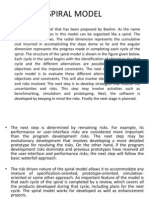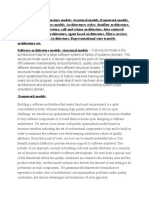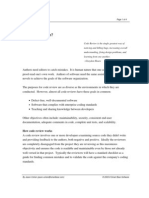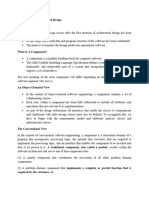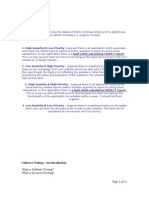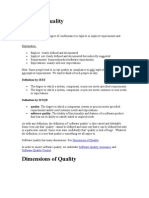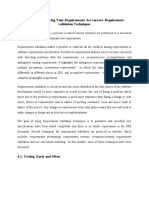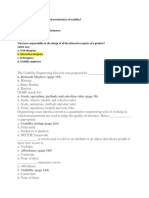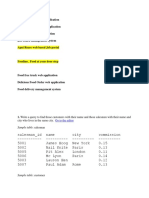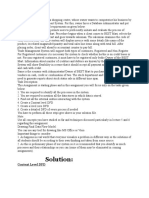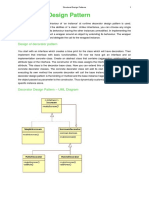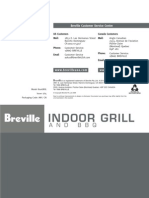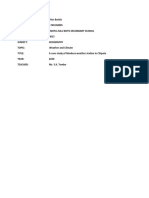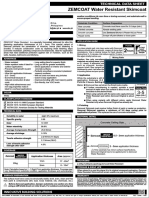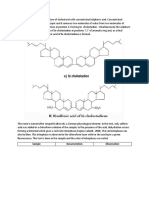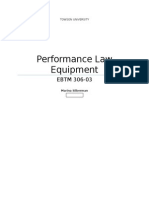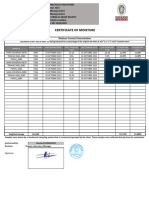Spiral Model
Spiral Model
Uploaded by
MNaveedsdkCopyright:
Available Formats
Spiral Model
Spiral Model
Uploaded by
MNaveedsdkOriginal Description:
Copyright
Available Formats
Share this document
Did you find this document useful?
Is this content inappropriate?
Copyright:
Available Formats
Spiral Model
Spiral Model
Uploaded by
MNaveedsdkCopyright:
Available Formats
Spiral Model
A risk-driven software process framework (the spiral model) was proposed by Barry Boehm in
1988. It integrates risk management and incremental development. The software process is
represented as a spiral rather than a sequence of activities with some backtracking from one
activity to another. Each loop in the spiral represents a phase of the software process. Thus, the
innermost loop might be concerned with system feasibility, the next loop with requirements
definition, the next loop with system design and so on. The spiral model combines change
avoidance with change tolerance. It assumes that changes are a result of project risks and
includes explicit risk management activities to reduce these risks.
The spiral model has four phases. A software project repeatedly passes through these phases in
iterations called Spirals.
The Radius of the spiral at any point represents the expenses (cost) of the project, and the angular
dimension represents the progress made so far in the current phase.
1. Objectives determination and identify alternative constraints: Requirements are
gathered from the customers and the objectives are identified, elaborated and analyzed at
the start of every phase. Project risks are identified. Alternative strategies, depending on
these risks, may be planned.
2. Identify and resolve Risks: For each of the identified project risks, a detailed analysis is
carried out. Steps are taken to reduce the risk. For example, if there is a risk that the
requirements are inappropriate, a prototype system may be developed.
3. Develop next version of the Product: During the third quadrant, the identified features
are developed and verified through testing. At the end of the third quadrant, the next
version of the software is available.
4. Review and plan for the next Phase: In the fourth quadrant, the Customers evaluate the
so far developed version of the software. In the end, planning for the next phase is
started.
Advantages
Provides early indication of the risks, without involving much cost.
Users can view the system early because of the rapid prototyping tools.
Critical high-risk functions are developed first.
The design does not have to be perfect.
Users can be closely involved in all lifecycle steps.
Early and frequent feedback from users.
Cumulative costs assessed frequently.
Disadvantages
Management is more complex.
End of the project may not be known early.
Not suitable for small or low risk projects and could be expensive for small projects.
Spiral model is complex to understand for new team members.
Risk assessment expertise is required.
Spiral may continue indefinitely.
Developers must be reassigned during non-development phase activities.
When to Use Spiral Model?
Creation of a prototype is appropriate.
When there is a budget constraint and risk evaluation is important.
A project is of medium to high-risk.
Users are unsure of their needs.
Requirements are complex.
Product-line is new.
Significant changes are expected during exploration.
Long-term project commitment unwise because of potential business changes.
You might also like
- Manual OltDocument136 pagesManual Oltcarlos juniorNo ratings yet
- SQM 16 & 2marks With AnsDocument21 pagesSQM 16 & 2marks With AnsKalyan SundaramNo ratings yet
- TRANSFER CASE Final Drive Control Module (FDCM) - Electrical Diagnostics - Ram Pickup PDFDocument139 pagesTRANSFER CASE Final Drive Control Module (FDCM) - Electrical Diagnostics - Ram Pickup PDFcharlesNo ratings yet
- Globalization and Prospects of The World Society - SzentesDocument16 pagesGlobalization and Prospects of The World Society - SzentesVincent Hansheng LiNo ratings yet
- Spiral ModelDocument8 pagesSpiral ModelManjeet SinghNo ratings yet
- Component-Based Software EngineeringDocument48 pagesComponent-Based Software EngineeringHarshavardhan Virendra Malla100% (1)
- Bug Tracking SystemDocument15 pagesBug Tracking Systembogi chanduNo ratings yet
- What Is The Software Development Life Cycle?Document12 pagesWhat Is The Software Development Life Cycle?Rahul JainNo ratings yet
- SEN Important Question: 1) Describe The Layered Technology Approach of Software EngineeringDocument49 pagesSEN Important Question: 1) Describe The Layered Technology Approach of Software EngineeringNilam adhavNo ratings yet
- Code Review Document: Virtual Museum ExplorerDocument13 pagesCode Review Document: Virtual Museum ExplorerSimran Radheshyam SoniNo ratings yet
- Software Testing Assignment OneDocument4 pagesSoftware Testing Assignment OneBosa BossNo ratings yet
- Unit VDocument24 pagesUnit VPrasad PatilNo ratings yet
- Paper 2 - Criteria For Selecting Software Development ModelsDocument6 pagesPaper 2 - Criteria For Selecting Software Development ModelsAndi MozartNo ratings yet
- Software Testing by Yogesh KhairnarDocument13 pagesSoftware Testing by Yogesh KhairnarYOGESH KHAIRNARNo ratings yet
- SDLC Waterfall ModelDocument3 pagesSDLC Waterfall ModelHasby RosyadiNo ratings yet
- SQM NotesDocument88 pagesSQM NotessoniiimoniiikaluNo ratings yet
- Welcome To: Knowledge Sharing 2020Document14 pagesWelcome To: Knowledge Sharing 2020star3michael3alabiNo ratings yet
- KBP Polytechnic, Kopargaon: Assignment No 1Document1 pageKBP Polytechnic, Kopargaon: Assignment No 1Shekhar KausalyeNo ratings yet
- Spiral Model Phases PlanningDocument3 pagesSpiral Model Phases PlanningshahbazNo ratings yet
- Unit 2 SADocument15 pagesUnit 2 SAbabyNo ratings yet
- What Is SDLC or Waterfall ModelDocument3 pagesWhat Is SDLC or Waterfall ModelAgrippa MungaziNo ratings yet
- C# CodeDocument25 pagesC# CodeKathryn MorrisonNo ratings yet
- SA Unit 3Document14 pagesSA Unit 3babyNo ratings yet
- 08 - Design Concepts - Pressman PDFDocument59 pages08 - Design Concepts - Pressman PDFTatianaPabonNo ratings yet
- Assignment 1Document4 pagesAssignment 1Deepak Wasge100% (1)
- Unit 1 Development Life Cycle ProcessesDocument44 pagesUnit 1 Development Life Cycle ProcessesRamesh KumarNo ratings yet
- Why Review CodeDocument4 pagesWhy Review CodeRoy MasraniNo ratings yet
- CSE3001 Software-Engineering ETH 1 AC39 PDFDocument8 pagesCSE3001 Software-Engineering ETH 1 AC39 PDFAnonymous TpYSenLO8aNo ratings yet
- CS435: Introduction To Software EngineeringDocument43 pagesCS435: Introduction To Software Engineeringsafrian arbiNo ratings yet
- Test ManagementDocument6 pagesTest ManagementLUIS ROBERTO HERNANDEZ AGUIRRENo ratings yet
- Modeling Component Level DesignDocument16 pagesModeling Component Level DesignVijaya AlukapellyNo ratings yet
- Software Testing ImpDocument52 pagesSoftware Testing ImpPinky ChandaNo ratings yet
- Course Code Software Engineering LTPJ CSE3001 2 0 2 4 4 Pre-Requisite - Syllabus VersionDocument2 pagesCourse Code Software Engineering LTPJ CSE3001 2 0 2 4 4 Pre-Requisite - Syllabus VersionGokul SrinathNo ratings yet
- Basics of Software Testing Part 1Document23 pagesBasics of Software Testing Part 1vidyaNo ratings yet
- Software Development Life Cycle (SDLC)Document49 pagesSoftware Development Life Cycle (SDLC)John RowlandNo ratings yet
- 1.software Testing MethodologiesDocument2 pages1.software Testing MethodologiesJr Ntr0% (1)
- Software Testing Course SyllabusDocument4 pagesSoftware Testing Course SyllabusZohaibNo ratings yet
- Review Techniques - Cost Impact of Software Defects, Code Review and Statistical AnalysisDocument27 pagesReview Techniques - Cost Impact of Software Defects, Code Review and Statistical AnalysispeterparkerspnNo ratings yet
- Risk ManagementDocument6 pagesRisk Managementsudarshan1985No ratings yet
- Software Engineering: (SDLC & Software Process Model)Document44 pagesSoftware Engineering: (SDLC & Software Process Model)sayma meemNo ratings yet
- Chapter 4: Ensuring Your Requirements Are Correct: Requirement Validation TechniquesDocument2 pagesChapter 4: Ensuring Your Requirements Are Correct: Requirement Validation TechniquesEndris Mamo100% (1)
- Lecture 12: Chapter 15: Review TechniquesDocument18 pagesLecture 12: Chapter 15: Review TechniquesswetaNo ratings yet
- SDLC ManualDocument19 pagesSDLC Manuala_kumkumaNo ratings yet
- Types of Interviews - HRMDocument19 pagesTypes of Interviews - HRMhaseebNo ratings yet
- Federaed LearningDocument3 pagesFederaed LearningSrinivasa Rao AngajalaNo ratings yet
- Question Bank - 2013 - Regulation PDFDocument14 pagesQuestion Bank - 2013 - Regulation PDFRevathi SaravananNo ratings yet
- Obligation Complexity Measure Over Code and Cognitive Complexity MeasuresDocument14 pagesObligation Complexity Measure Over Code and Cognitive Complexity MeasuresFathulloh MukhlashinNo ratings yet
- Chapter 1 - SPMDocument21 pagesChapter 1 - SPMHEMANT THAKAR100% (1)
- AnswerDocument4 pagesAnswerFernando SalasNo ratings yet
- Integration TestingDocument3 pagesIntegration TestinganilNo ratings yet
- Unit - III Testing - Unit Testing, Black-Box Testing, White-Box TestingDocument6 pagesUnit - III Testing - Unit Testing, Black-Box Testing, White-Box Testingbright.keswaniNo ratings yet
- Software Engineering: Instructor Ms. Shakra MehakDocument22 pagesSoftware Engineering: Instructor Ms. Shakra MehakHAMZA KHALIDNo ratings yet
- Csc601 Software-Engineering TH 1.10 Ac26Document2 pagesCsc601 Software-Engineering TH 1.10 Ac26netgalaxy2010No ratings yet
- Unit Testing and JUnitDocument83 pagesUnit Testing and JUniteliasferhan1992No ratings yet
- Advanced JAVA ProgrammingDocument7 pagesAdvanced JAVA ProgrammingSaurabh TargeNo ratings yet
- Nptel Week1Document134 pagesNptel Week1Abrar AhamadNo ratings yet
- COT-216 and IT-313 Software Engg PDFDocument18 pagesCOT-216 and IT-313 Software Engg PDFPardeep SinghNo ratings yet
- ST Lecture2 Fundamental Test ProcessDocument19 pagesST Lecture2 Fundamental Test ProcessHajjNo ratings yet
- Version Control SystemsDocument6 pagesVersion Control SystemsTgowtham ArasuNo ratings yet
- Defect & Test ManagementDocument12 pagesDefect & Test ManagementJU PMIT Sabuj0% (1)
- Software Security Vulnerability A Complete Guide - 2020 EditionFrom EverandSoftware Security Vulnerability A Complete Guide - 2020 EditionNo ratings yet
- Making Sense of Agile Project Management: Balancing Control and AgilityFrom EverandMaking Sense of Agile Project Management: Balancing Control and AgilityNo ratings yet
- Data GeneralizationDocument3 pagesData GeneralizationMNaveedsdkNo ratings yet
- Hci TestDocument3 pagesHci TestMNaveedsdkNo ratings yet
- The SQL Select Distinct StatementDocument5 pagesThe SQL Select Distinct StatementMNaveedsdkNo ratings yet
- Assignment ERDDocument1 pageAssignment ERDMNaveedsdkNo ratings yet
- Lect 2Document21 pagesLect 2MNaveedsdkNo ratings yet
- FURPSDocument3 pagesFURPSMNaveedsdk100% (1)
- Human Computer InteractionDocument4 pagesHuman Computer InteractionMNaveedsdkNo ratings yet
- Rational Unified Process (RUP)Document3 pagesRational Unified Process (RUP)MNaveedsdkNo ratings yet
- Concurrent ModelDocument5 pagesConcurrent ModelMNaveedsdk100% (2)
- SCMDocument20 pagesSCMMNaveedsdkNo ratings yet
- Test 1Document1 pageTest 1MNaveedsdkNo ratings yet
- Topics in Behavioral DesignDocument59 pagesTopics in Behavioral DesignMNaveedsdkNo ratings yet
- C## Short Questions. Q1:Write A Difference Between Static or Dynamic Polymorphism?Document4 pagesC## Short Questions. Q1:Write A Difference Between Static or Dynamic Polymorphism?MNaveedsdkNo ratings yet
- System ModelDocument10 pagesSystem ModelMNaveedsdkNo ratings yet
- SQL PracticeDocument4 pagesSQL PracticeMNaveedsdkNo ratings yet
- The Role of Trademarks in Marketing: Designing A TrademarkDocument2 pagesThe Role of Trademarks in Marketing: Designing A TrademarkMNaveedsdkNo ratings yet
- LCA4622 - Cyber LawDocument4 pagesLCA4622 - Cyber LawMNaveedsdkNo ratings yet
- Null Values: CHAPTER 5 (6/E) CHAPTER 8 (5/E)Document13 pagesNull Values: CHAPTER 5 (6/E) CHAPTER 8 (5/E)MNaveedsdkNo ratings yet
- 1506 CSharp and - Net Concepts CSE 407Document2 pages1506 CSharp and - Net Concepts CSE 407MNaveedsdkNo ratings yet
- Solution:: Context Level DFDDocument3 pagesSolution:: Context Level DFDMNaveedsdkNo ratings yet
- Mr. Khawaja Mansoor: Intellectual Property Law and GlobalisationDocument11 pagesMr. Khawaja Mansoor: Intellectual Property Law and GlobalisationMNaveedsdkNo ratings yet
- IPR Unit5Document39 pagesIPR Unit5MNaveedsdkNo ratings yet
- IPR and Cyber Law MCQDocument2 pagesIPR and Cyber Law MCQMNaveedsdk100% (4)
- A Study On Call Processing and Understanding of Signal in GSM NetworkDocument7 pagesA Study On Call Processing and Understanding of Signal in GSM NetworkMNaveedsdkNo ratings yet
- Use Case Diagrams & Sequence Diagrams: SE3A04 - TutorialDocument20 pagesUse Case Diagrams & Sequence Diagrams: SE3A04 - TutorialMNaveedsdkNo ratings yet
- COMP103 Revision: Exam-Style Revision QuestionsDocument4 pagesCOMP103 Revision: Exam-Style Revision QuestionsMNaveedsdkNo ratings yet
- Airbus A310 FCOM Vol 1 AIC Rev 39 Oct 2007 - 1228527939Document8 pagesAirbus A310 FCOM Vol 1 AIC Rev 39 Oct 2007 - 1228527939TomeuNo ratings yet
- Placement of Wind Turbines Using Genetic Algorithms: S.A. Grady, M.Y. Hussaini, M.M. AbdullahDocument12 pagesPlacement of Wind Turbines Using Genetic Algorithms: S.A. Grady, M.Y. Hussaini, M.M. AbdullahjeanNo ratings yet
- Ro-Buh-Qpl: Express WorldwideDocument3 pagesRo-Buh-Qpl: Express WorldwideverschelderNo ratings yet
- Avoid Making Losses in Stock MarketDocument1 pageAvoid Making Losses in Stock MarketPrajata DasChowdhuryNo ratings yet
- Structural Design PatternDocument34 pagesStructural Design PatternAkula SandeepNo ratings yet
- Breville 800GRXL ManualDocument96 pagesBreville 800GRXL ManualBrevilleNo ratings yet
- Cbse School PAT 2019-BUNDELKHAND PDFDocument26 pagesCbse School PAT 2019-BUNDELKHAND PDFMONISH NAYARNo ratings yet
- IT101 SyllabusDocument9 pagesIT101 SyllabusKatelyn RellitaNo ratings yet
- Semester-Long Internship Report: Tanmay Srinath (BMSCE, Bangalore)Document31 pagesSemester-Long Internship Report: Tanmay Srinath (BMSCE, Bangalore)hiiNo ratings yet
- Experimentalstudies On The Effects of Reduction in Gear Tooth Stiffness Lubricant Film Thicknessina Spur Geared SystemDocument13 pagesExperimentalstudies On The Effects of Reduction in Gear Tooth Stiffness Lubricant Film Thicknessina Spur Geared SystemBurak TuncerNo ratings yet
- Haven - A Small Cat - S Big Adventure Megan Wagner Lloyd 2022 Candlewick PressDocument80 pagesHaven - A Small Cat - S Big Adventure Megan Wagner Lloyd 2022 Candlewick PressspnoneNo ratings yet
- Digital Booklet - Mamma Mia!Document7 pagesDigital Booklet - Mamma Mia!Alessandro SorzeNo ratings yet
- GiereUnderstanding Scientific Reasoning PDFDocument15 pagesGiereUnderstanding Scientific Reasoning PDFAna Laura SotoNo ratings yet
- Consumer Protection Rights in BangladeshDocument34 pagesConsumer Protection Rights in Bangladeshmd.jewel ranaNo ratings yet
- Geography Field ProjectDocument31 pagesGeography Field ProjectGeorge Mulenga100% (1)
- QBM101Document37 pagesQBM101Shang BinNo ratings yet
- Arrest How MadeDocument19 pagesArrest How MadeNARANJA DIZZA MAKAKENANo ratings yet
- Zemcoat Water Resistant Technical Data SheetDocument1 pageZemcoat Water Resistant Technical Data SheetAiris Joy RojasNo ratings yet
- Otc 6267 MSDocument16 pagesOtc 6267 MSnandani sudamaNo ratings yet
- 5 Powerful Lessons in The Life of Cain and Abel 1Document5 pages5 Powerful Lessons in The Life of Cain and Abel 1Mercy Balagosa Palmares100% (1)
- Salkowski Test & ConclusionDocument3 pagesSalkowski Test & ConclusionJezKagandahan40% (5)
- Modu Tek CatalogDocument184 pagesModu Tek Catalogiskierdo10No ratings yet
- Ebtm 306 ProjectDocument17 pagesEbtm 306 Projectapi-283711983No ratings yet
- OGV082 MV GENIUSHIP Moisture Reportps84Document1 pageOGV082 MV GENIUSHIP Moisture Reportps84masterablhawkNo ratings yet
- Medical Colleges in PakistanDocument11 pagesMedical Colleges in Pakistanzainab_farooquiNo ratings yet
- Secondary Control PP PDFDocument60 pagesSecondary Control PP PDFbrunosamaeian100% (1)
- Basic Concept Method:: Flexural Stresses: Second Moment of Inertia, IDocument6 pagesBasic Concept Method:: Flexural Stresses: Second Moment of Inertia, IJeremiah VillanuevaNo ratings yet




